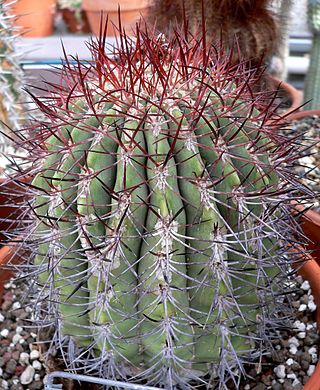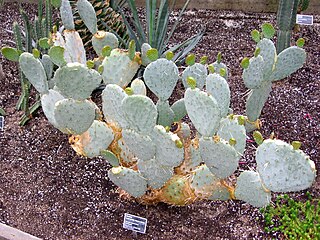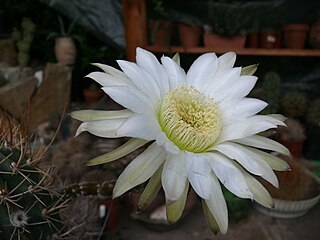
Stetsonia coryne, the toothpick cactus, is the sole species in the cactus genus Stetsonia. Stetsonia coryne is native to arid regions of South America, where it grows to a height of 15 to 25 ft tall. It contains mescaline and other alkaloids.

Opuntia engelmannii is a prickly pear common across the south-central and Southwestern United States and northern Mexico. It goes by a variety of common names, including desert prickly pear, discus prickly pear, Engelmann's prickly pear in the US, and nopal, abrojo, joconostle, and vela de coyote in Mexico.

Trichocereus macrogonus, synonym Echinopsis macrogonus, is a species of cactus found in Ecuador, Peru and Bolivia. Two varieties are accepted as of September 2023: var. macrogonus and var. pachanoi. Plants contain varying amounts of the psychoactive alkaloid mescaline. They have been used both ritually and in traditional medicine from pre-Columbian times. Trichocereus macrogonus is one of a number of similar species that may be called San Pedro cactus. Indigenous names include achuma and huachuma, although these too may be applied to similar species.

Ferocactus pilosus, also known as Mexican lime cactus or Mexican fire barrel, is a species of cactus in North America.

Soehrensia candicans is a species of cactus from northern and western Argentina. It has large fragrant white flowers that open at night.

Oreocereus celsianus, or the old man of the mountain is a member of the family Cactaceae native to the high lands of the Andes in South America, and is named for its fluffy white hair, which may protect it from intense sunlight and extreme temperatures.

Cochemiea goodridgei is a species of plant in the family Cactaceae. It is endemic to Mexican state Baja California.

Ferocactus pottsii is a species of Ferocactus from Mexico. The specific epithet has also been spelt pottsi.
Opuntia abjecta is a short cactus, perhaps to 15(25) cm tall. It occurs in the Florida Keys and has been conflated with O. triacantha. Recent work shows that the two taxa are distinct. In addition to morphological and phylogenetic (DNA) differences, O. triacantha occurs in Cuba, whereas O. abjecta occurs in Florida. Currently It is Listed as critically endangered by the IUCN Red List.

Opuntia cacanapa is a cactus in the genus Opuntia. In the United States, it is found primarily in the southern Trans-Pecos and the South Texas Plains from Brewster, Pecos, and Uvalde Counties south to Cameron County. It also occurs in nearby Mexico from the Rio Grande to as far south as Guanajuato and northern Hidalgo.

Denmoza is a monotypic genus of cacti. Its only species, Denmoza rhodacantha, is native to northwest Argentina.

Ferocactus haematacanthus is a species of Ferocactus from Mexico.

Opuntia hyptiacantha is a species of plant that belongs to the family Cactaceae. They can be found in Mexico within Durango, Aguascalientes, Zacatecas, San Luis Potosí, Jalisco, Guanajuato, Querétaro, and the State of Mexico.

Echinopsis strigosa, is a species of Soehrensia in the cactus family. It is native to north western Argentina. It was first published in Cactaceae Syst. Init. 28: 31 in 2012.

Echinocereus scheeri is a species of hedgehog cactus in the family Cactaceae, native to northern Mexico. With its dramatic offsets, it has gained the Royal Horticultural Society's Award of Garden Merit.

Opuntia setispina is a species of cactus found in the Sierra Madre Occidental in Chihuahua, Sonora, and Durango in Mexico. The name O. setispina has been listed as a synonym under Opuntia macrorhiza and Opuntia pottsii, but shows no close relationship to either species. It is more of a woody shrubby, often somewhat tree-like species, growing up to approximately 1 meter tall and wide. It is morphologically similar to Opuntia chlorotica, Opuntia santa-rita, and Opuntia gosseliniana.

Matucana haynii is a species of Matucana found in Peru.

Acanthocalycium leucanthum is a species of flowering plant in the cactus family Cactaceae from Argentina.

Echinocereus salm-dyckianus is a species of plant found in Mexico.

Echinocereus acifer is a species of Echinocereus found in Mexico





















